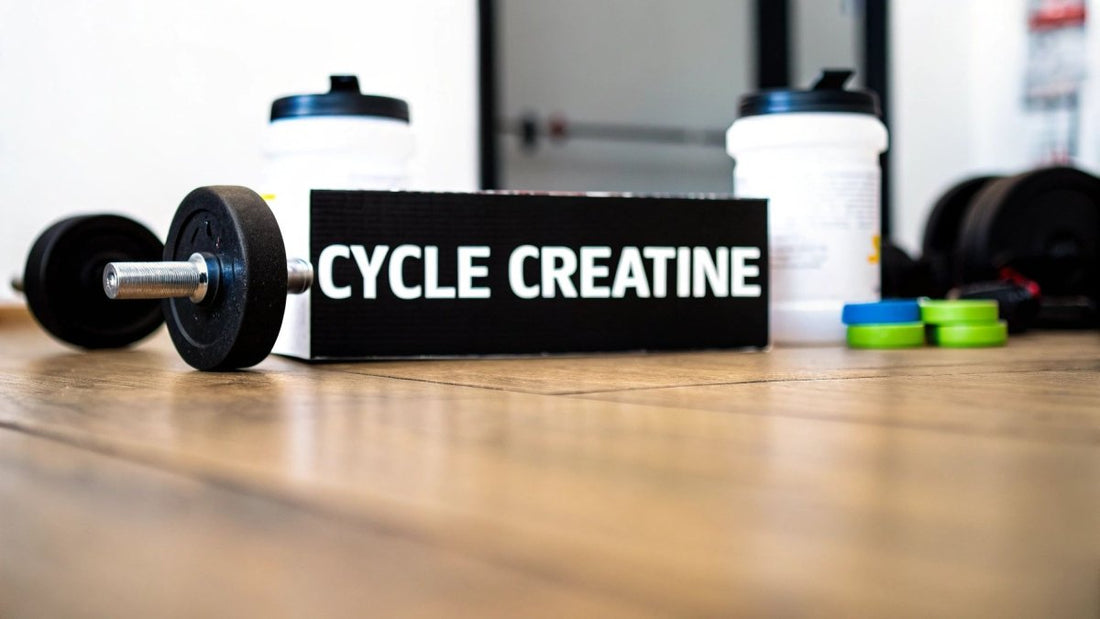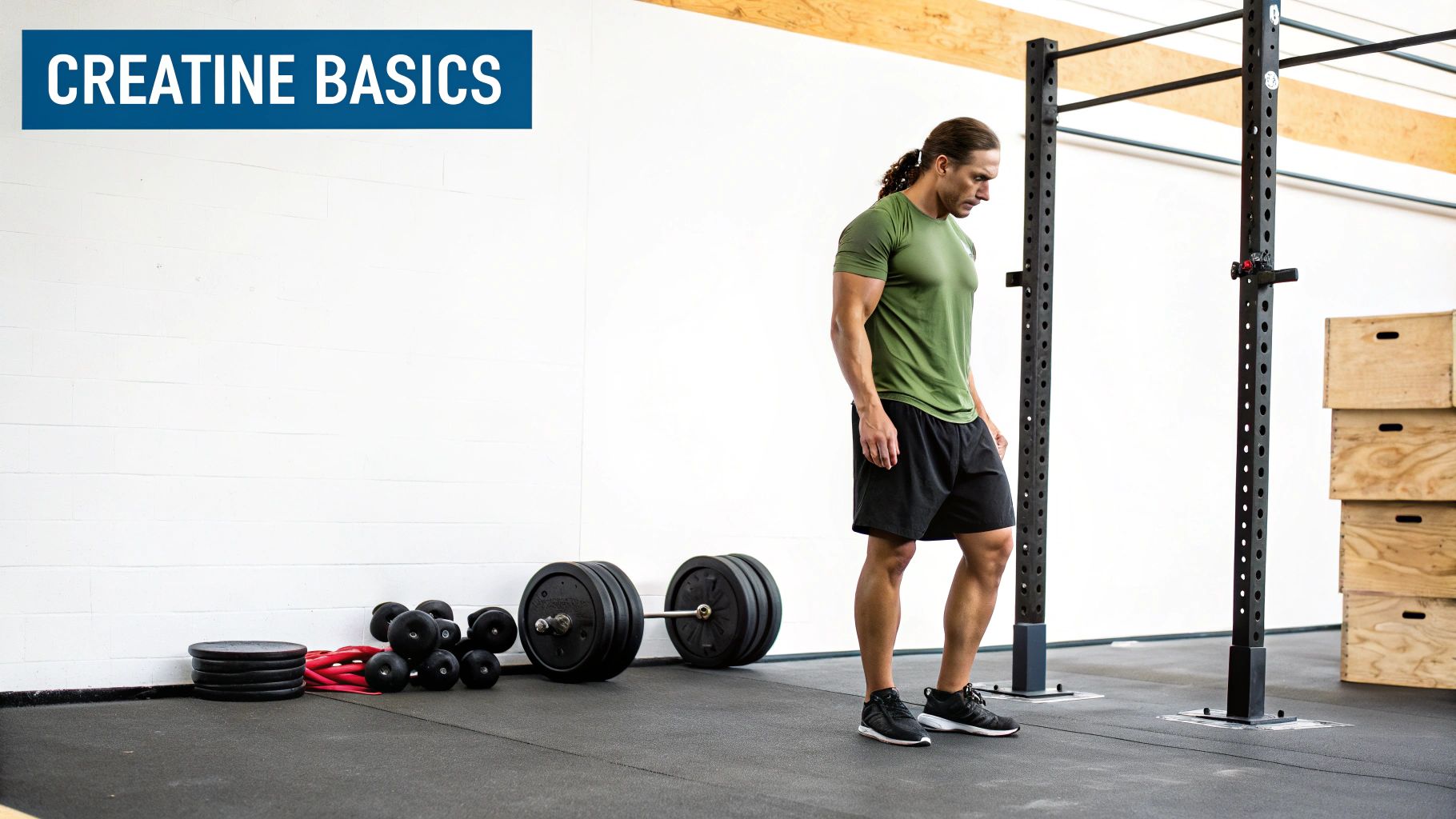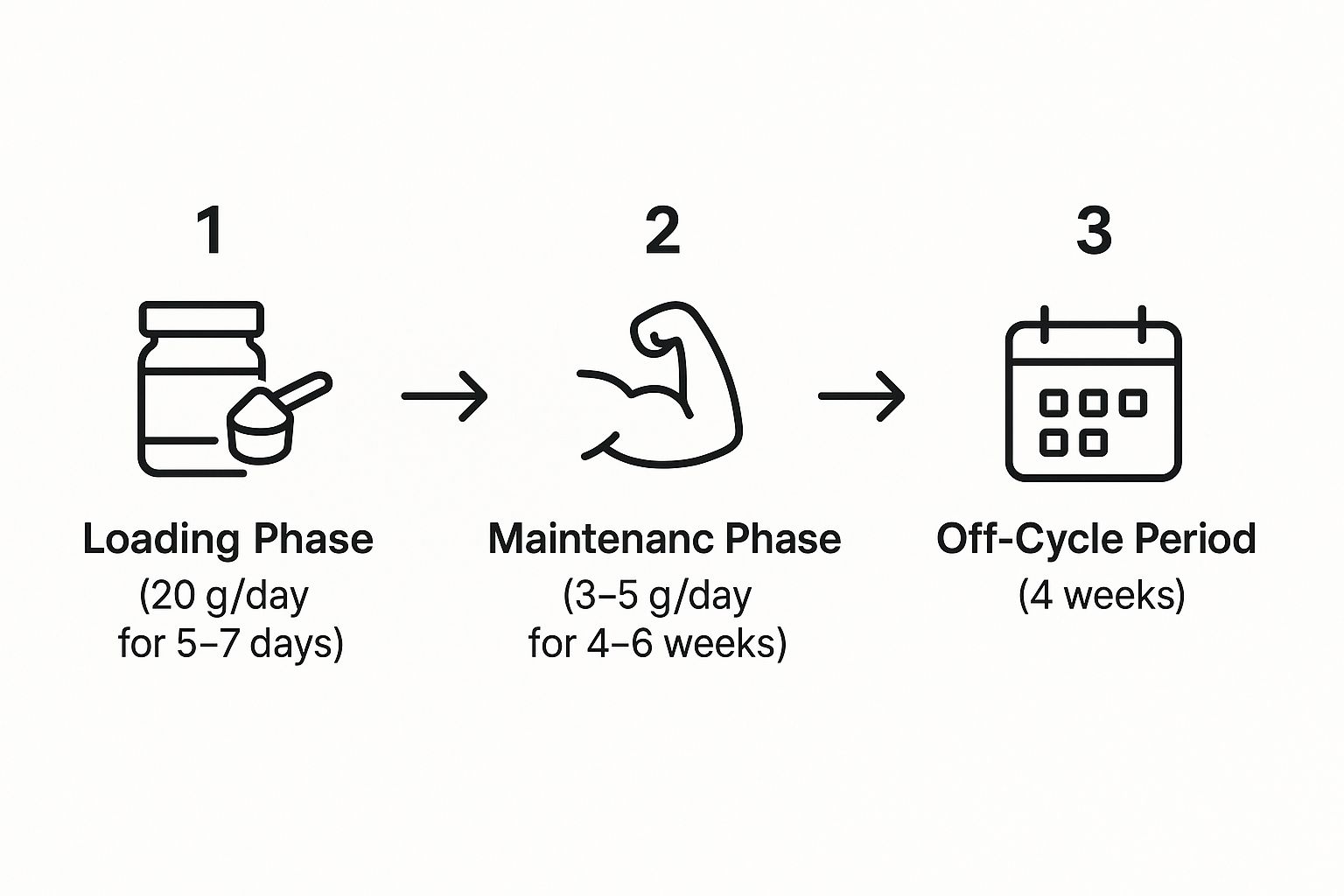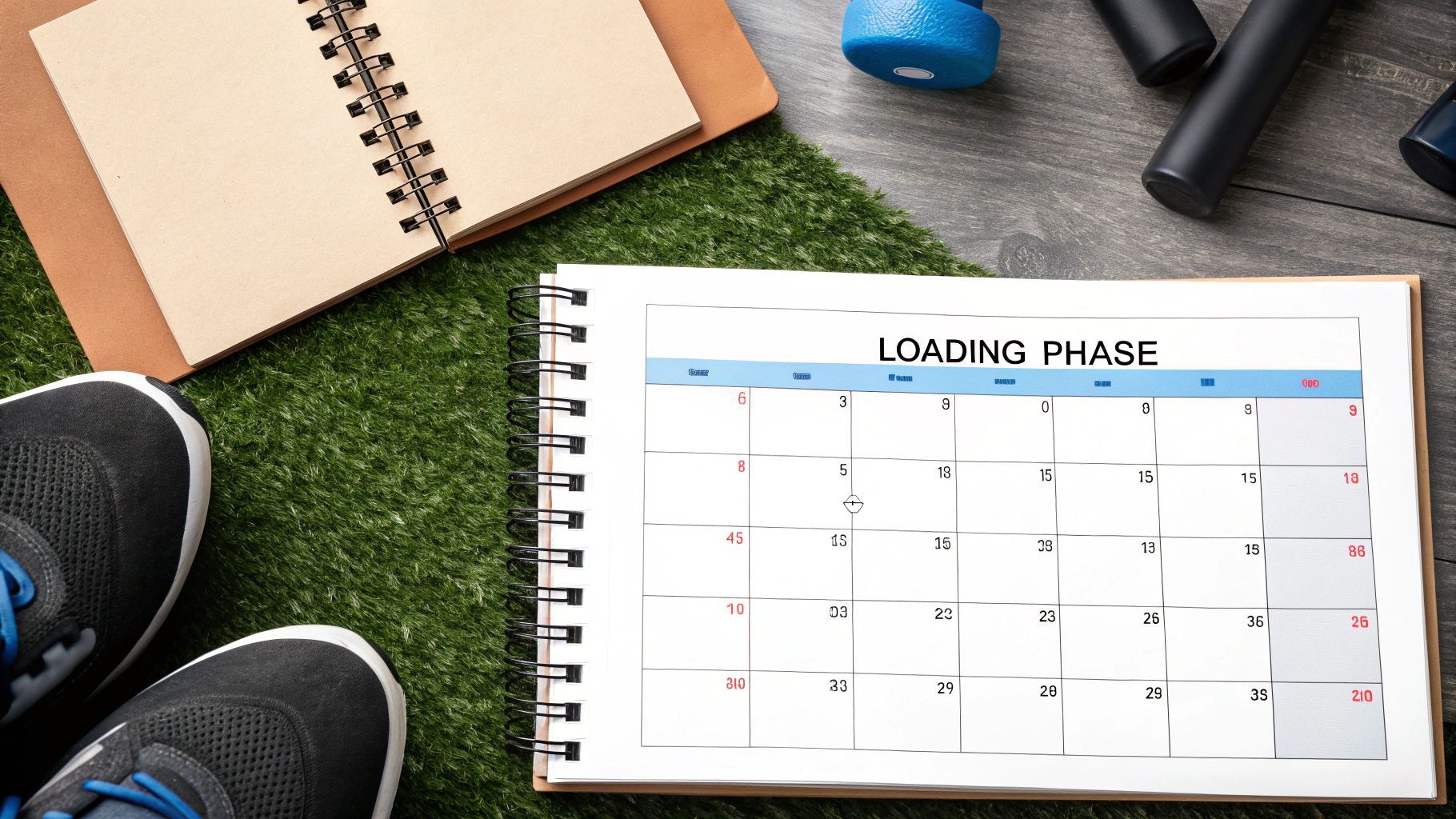
How to Cycle Creatine for Maximum Results
Share
Before we even get into the "how," let's tackle the big question: Is cycling creatine even necessary?
For most people, the simple answer is no. Modern research has pretty much put this debate to bed, showing that continuous, long-term use is both safe and effective. Still, the idea of cycling hangs around for a reason, so it's worth understanding the arguments to decide what's best for you.
Should You Cycle Creatine in the First Place?

The whole concept of cycling creatine—using it for a few weeks or months, then taking a break—is a holdover from old-school bodybuilding wisdom. The theory was that if you took it all the time, your body's natural creatine transporters would get lazy or "down-regulated."
The fear was that your muscles would stop absorbing the supplement as well, making it less effective over time. Taking a break, or a "washout period," was supposed to hit the reset button on these receptors, making your next cycle just as potent as the first.
What the Science Says Today
Here's the thing: the overwhelming majority of current scientific studies just don't back up that down-regulation theory. Research has shown time and again that consistent, long-term creatine supplementation is perfectly safe and keeps working.
Your body doesn't seem to build up a tolerance to creatine the way it does to something like caffeine. As long as you stick with a standard maintenance dose, your muscles will stay fully saturated, and you'll keep getting all those great performance benefits. This has led most experts to agree that cycling is an unnecessary complication for the average person.
So, When Might Cycling Actually Make Sense?
Is the idea completely dead, then? Not quite. There are a few specific scenarios where someone might choose to cycle, and they can be perfectly valid.
-
Competitive Athletes: Someone trying to make a specific weight class, like a fighter or weightlifter, might strategically stop taking creatine a few weeks before a competition. This helps them shed the extra water weight that creatine makes you hold, which can be just enough to hit their target.
-
Personal Preference: Some people just don't like the idea of taking any supplement indefinitely. They prefer to give their body a break now and then, just as a personal principle. There's nothing wrong with that.
-
The Rare "Non-Responder" Feeling: Though it's uncommon, some individuals report that they feel like the effects of creatine start to fade after many months of continuous use. For this small group, taking a 2-4 week break might subjectively bring back that initial kick.
Ultimately, getting results from creatine is all about proper dosing to saturate your muscles. A classic approach is taking a higher dose of about 20 grams per day for five days to load up quickly, followed by a steady 3-5 grams daily to maintain those levels. This strategy is proven to crank up muscle creatine stores, which directly fuels better performance in short, intense bursts of activity. You can find more deep dives into its effectiveness and safety over on GSSIweb.org.
Key Takeaway: For the average person hitting the gym, the science is clear—you don't need to cycle creatine. Sticking with a consistent daily dose is a simple, proven, and safe way to get results. Cycling just adds a layer of complexity that isn't necessary for most people.
How to Do the Creatine Loading Phase
The loading phase is a popular strategy to quickly max out your muscle's creatine stores. Think of it as a jump-start. Instead of waiting several weeks for creatine levels to build up, you can get there in about a week, fast-tracking your results.
While it's totally optional, many people swear by it for seeing quicker gains in strength and performance right out of the gate. The most tried-and-true method involves taking 20 grams of creatine monohydrate daily for a short period, typically 5 to 7 days.
Structuring Your Daily Doses
Now, don't just dump 20 grams into a shaker and chug it down. That's a surefire way to upset your stomach. The trick is to split that daily total into smaller, more manageable servings throughout the day.
The best practice is to break the 20 grams into four separate 5-gram doses. This approach prevents your system from getting overwhelmed and gives your muscles a steady supply to absorb.
Taking smaller, more frequent doses not only minimizes the risk of gastrointestinal discomfort but may also enhance overall uptake by preventing your body from simply excreting the excess.
For a deeper dive into this initial stage, our guide on the loading phase for creatine monohydrate has all the details you'll need. Just remember, consistency is everything during this first week.
Maximizing Absorption for Better Results
To get the most bang for your buck, pay attention to what you take your creatine with. Mixing it with a source of simple carbohydrates can make a real difference.
Why? Carbs trigger an insulin response, and insulin helps transport nutrients—including creatine—into your muscle cells more effectively. A glass of juice or a carb-heavy meal can significantly boost absorption.
To give you a clear picture of how this works in the real world, here’s a sample schedule for a typical loading day.
Sample Creatine Loading Phase Schedule (20g/day)
This table breaks down a simple way to space out your four daily doses to maximize absorption and fit seamlessly into your routine.
| Time of Day | Dosage | Mixing Suggestion |
|---|---|---|
| Morning | 5g | With a glass of grape juice or in a breakfast smoothie. |
| Midday | 5g | With your lunch, ideally one with a good carb source. |
| Pre-Workout | 5g | About 30 minutes before your workout with a carb drink. |
| Post-Workout | 5g | Mixed into your post-workout shake with protein and carbs. |
Following a simple schedule like this one for 5-7 days will get your muscles fully saturated and ready for the maintenance phase.
This image shows exactly how the loading phase kicks off the entire creatine cycle.

As you can see, the cycle starts with this short, high-dose loading period before transitioning into a longer maintenance phase and, eventually, an off-cycle. It’s a complete roadmap for your supplementation strategy.
Maintaining Gains with a Smart Dosing Strategy

Alright, you've made it through the loading phase. Your muscles are now fully saturated with creatine, and the real work begins. The goal isn't to keep cramming more in; it's to shift into a smart, sustainable strategy to keep those levels topped off.
This is what we call the maintenance phase.
You'll dial back your intake significantly from the loading dose. For most people, 3-5 grams of creatine monohydrate per day is the gold standard. This might not sound like much, but it’s precisely what your body needs to replace the creatine it naturally breaks down daily.
Think of this as the long haul of your creatine cycle, usually lasting between 4 to 10 weeks. This is where you’ll lock in those consistent gains in strength and performance.
Fine-Tuning Your Daily Dose
While that 3-5 gram range is a great starting point, it's not a hard-and-fast rule. A few personal factors can help you decide whether to lean toward the lower or higher end of the spectrum.
- Body Weight: If you're a larger athlete with more muscle mass, sticking closer to the 5-gram mark is a good idea. This helps ensure your bigger muscles stay completely saturated.
- Training Intensity: Going through a particularly brutal training block? A slightly higher dose can give your recovery and performance a little extra support when you need it most.
The objective here is simple: replace what you use. Your muscle cells are already full from the loading phase, so this is just about keeping the tank from dipping low. For a deeper dive into adjusting your intake, our complete creatine dosage guide has you covered.
Optimizing Your Timing for an Edge
When you take your daily dose matters, but maybe not as much as you think. Consistency is king. Taking it at the same time every day is far more important than hitting a perfect 30-minute window.
That said, some research suggests that post-workout timing might give you a slight advantage. Taking creatine after you train could enhance its impact on your performance and body composition.
My go-to recommendation? Toss your 3-5 gram scoop into your post-workout shake. The combination of protein and carbs creates an insulin spike that can help shuttle that creatine into your muscle cells more efficiently.
This long-term maintenance is the heart of an effective creatine cycle. It's how you ensure you keep reaping the rewards of increased strength and power week after week. But remember, supplements are only one piece of the puzzle. Combining your creatine strategy with proven muscle recovery tips for better performance is what truly maximizes your gains and keeps you hitting new PRs.
Navigating The Off-Cycle And What To Expect
So, you’ve been consistently using creatine for several weeks and seeing great results. Now what? The traditional approach to creatine cycling introduces a strategic break at this point—what we call the "off-cycle" or "washout period."
The thinking behind this break has always been that it gives your body's natural creatine transporters a chance to reset. In theory, this could make them more responsive and efficient when you start supplementing again.
The Creatine "Washout" Period
Taking a break is simple: you just stop taking creatine completely. The typical off-cycle lasts anywhere from 2 to 4 weeks.
During this time, the extra creatine you've stored in your muscles will gradually deplete, eventually returning to your normal baseline levels. It took a while to build them up, and it'll take a few weeks for them to wash out. This is a completely normal part of the process, so don't sweat it.
What Really Happens When You Stop?
The biggest fear I hear from lifters is losing all their hard-earned muscle. Let me put that to rest right now: it's not going to happen. The actual muscle tissue you built in the gym isn't going anywhere. You will, however, notice a few temporary changes as your body adjusts.
- You'll Drop Some Water Weight: Creatine is famous for pulling water into your muscle cells, which is what gives you that full, pumped look. When you stop taking it, your muscles will let go of some of that extra water. You might see the scale drop by a few pounds, but remember, this is just water, not muscle or fat.
- Performance Might Dip Slightly: You may notice that you can't eke out that last tough rep on your big lifts. With less creatine phosphate available for quick energy, a small drop in explosive strength and endurance is expected. It's a minor change, but it's good to be mentally prepared for it.
The off-cycle is just a strategic pause, not a step backward. It's a temporary phase designed to prime your body for the next round. The real strength you built is still there.
Understanding this is key. A lot of people get discouraged during their first off-cycle, thinking they're losing progress. But you're just hitting the reset button.
If you want to understand how this works in reverse, check out our guide on how long it takes to see results from creatine, which explains the saturation process.
The most important thing is to keep your training intensity and nutrition on point. Even if your performance dips a little, continuing to train hard is what locks in your strength gains. Think of the off-cycle as a bridge to your next, even more effective, creatine cycle.
Adapting Your Creatine Cycle to Your Sport

There’s no such thing as a one-size-fits-all plan in fitness, and that’s certainly true when it comes to supplementing with creatine. A powerlifter’s strategy for hitting a new personal best on the squat is going to look a lot different than how a cyclist fuels up for a final sprint. To really get the most out of creatine, you need to understand the unique demands of your sport.
It all boils down to your training goals. Are you focused on raw, explosive strength for a few seconds of intense effort, or do you need to maintain power over a much longer period? How you answer that question will determine your whole approach—from loading and maintenance right down to your off-cycles.
For Strength and Power Athletes
If you spend your time chasing heavy lifts, whether you're a powerlifter, bodybuilder, or sprinter, the classic creatine cycle was practically made for you. The benefits line up perfectly with what you’re trying to achieve: more ATP for that extra rep, a jump in power output, and quicker recovery between those grueling sets.
For these kinds of athletes, a traditional cycle is a great fit:
- Loading Phase: Kick things off with a 5-7 day loading period, taking 20 grams a day to get your muscles fully saturated fast.
- Maintenance Phase: After that, drop down to a steady 3-5 grams daily for 8-12 weeks to keep those levels topped off during your main training block.
- Off-Cycle: Finally, take a 2-4 week break. This is a perfect time to line it up with a deload week or your off-season to give your body a reset before the next big push.
This tried-and-true method ensures your muscles are primed for maximum force when it really counts—when you're under the bar or exploding off the starting line.
For Endurance Athletes
Now, for endurance athletes like long-distance runners and cyclists, the relationship with creatine gets a bit more complicated. The biggest hurdle is usually the potential for water retention. When your power-to-weight ratio is everything, gaining even a couple of pounds of water weight can be a real problem when you’re trying to climb a hill or hold a certain pace for miles on end.
Because of this, a full-blown loading phase is often not just unnecessary but can actually work against you. A much more strategic and subtle approach usually works better. In fact, many endurance athletes skip the loading phase altogether and just stick with a lower maintenance dose of 3 grams per day.
This approach still offers a nice little performance boost without the noticeable water retention. The goal isn't to bulk up; it's to have that extra gear for those moments when the intensity spikes, like a breakaway sprint at the end of a race. For cyclists, creatine’s real magic shines in those short, all-out efforts, not so much during the long, steady parts of a ride. To see a great breakdown of this, check out this informative video on YouTube about creatine for cyclists.
Pro Tip for Endurance Athletes: Try timing your creatine use with specific training blocks. You could cycle on during a phase focused on high-intensity interval training (HIIT) to really push your power development. Then, cycle off when you’re in a base-building period where the volume is high but the intensity is lower.
In the end, learning how to cycle creatine is really about learning your own body and sport. A strength athlete might follow the classic protocol by the book, while a marathoner might use it more surgically to sharpen their finishing kick. The real key is to take the principles and adapt them to what you need to perform your best.
Common Questions About Cycling Creatine
Even with the best plan in hand, you're bound to have questions when you start cycling creatine. It's a supplement surrounded by a ton of old gym lore and evolving science, so it's smart to clear things up. Let's dig into the questions I hear most often so you can feel confident in your approach.
One of the first things people get hung up on is that initial loading phase.
Is a Loading Phase Absolutely Necessary?
Honestly? No, not at all. Think of the loading phase as an accelerator pedal. Its only job is to get your muscles completely saturated with creatine as fast as possible, which usually takes about a week.
But you can get to the exact same place by just starting with a standard maintenance dose of 3-5 grams per day. The only difference is the timeline. Without loading, it’ll take you closer to 3-4 weeks to max out your muscle stores. So if you'd rather take a more gradual approach or have a sensitive stomach, skipping the load is a perfectly fine strategy.
Another big one is what to do when life happens and you miss a day.
Don't sweat it. Seriously. Missing a single dose won't throw you off course, especially once your muscles are already saturated. Your creatine stores drain very slowly.
Just hop back on your regular schedule the following day. There’s absolutely no need to double up to "catch up"—that’s just a good way to potentially upset your stomach for no real benefit. Consistency over the long haul is what builds results, not daily perfection.
Do I Really Need to Cycle Off Creatine?
Ah, the great debate. The original logic behind cycling off was to give your body a break and let its natural production and transport systems "reset." It made sense at the time, but the science has moved on.
Modern research overwhelmingly shows that continuous, long-term use of a 3-5 gram maintenance dose is perfectly safe for healthy people. Your body doesn't "forget" how to respond to it. Today, taking a break from creatine is more of a personal choice or an old-school habit than a scientific requirement. Plenty of athletes stay on it year-round without any problems.
And finally, the fear that keeps some people from even starting…
Will I Lose My Muscle When I Stop Taking Creatine?
Let’s be clear: you will not lose the actual muscle tissue you’ve worked so hard to build in the gym. When you stop taking creatine, your muscles will simply release the extra water they were holding onto.
Here’s what you should actually expect:
- A Small Drop on the Scale: This is purely water weight, not muscle or fat.
- Muscles May Look a Bit "Flatter": That extra water gives you a fuller, more "pumped" look, which will naturally decrease.
- A Slight Dip in Peak Strength: You might notice that last, super-tough rep on your heaviest lift is just a little harder to hit.
The real strength and size you built from training isn't going anywhere. An off-cycle is just a temporary pause, not a step backward.
Ready to make your creatine routine simpler and tastier? Smash.com offers premium creatine gummies that deliver the full 5g dose without the mess of powders. Ditch the shaker and enjoy delicious, on-the-go supplementation. Check out our flavors and smash your fitness goals at https://smash.com.